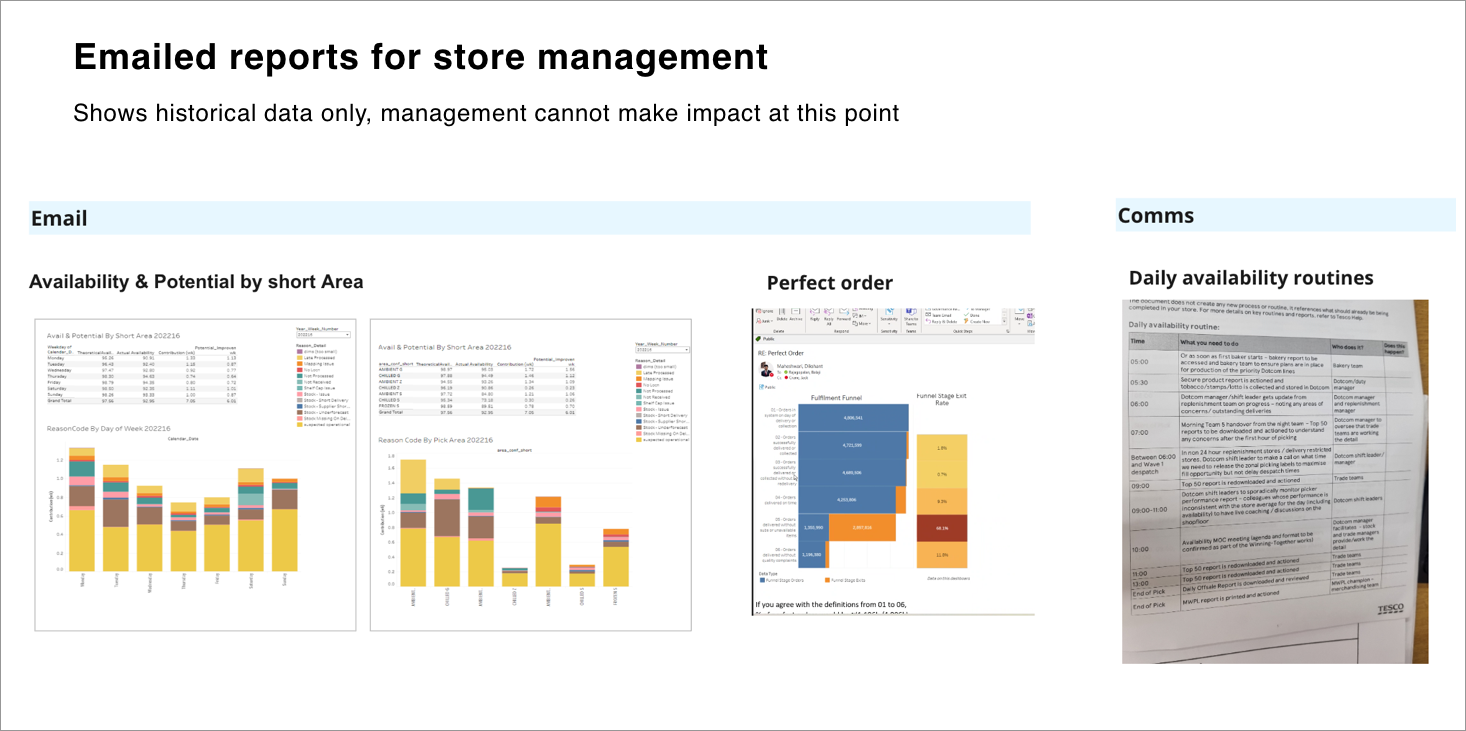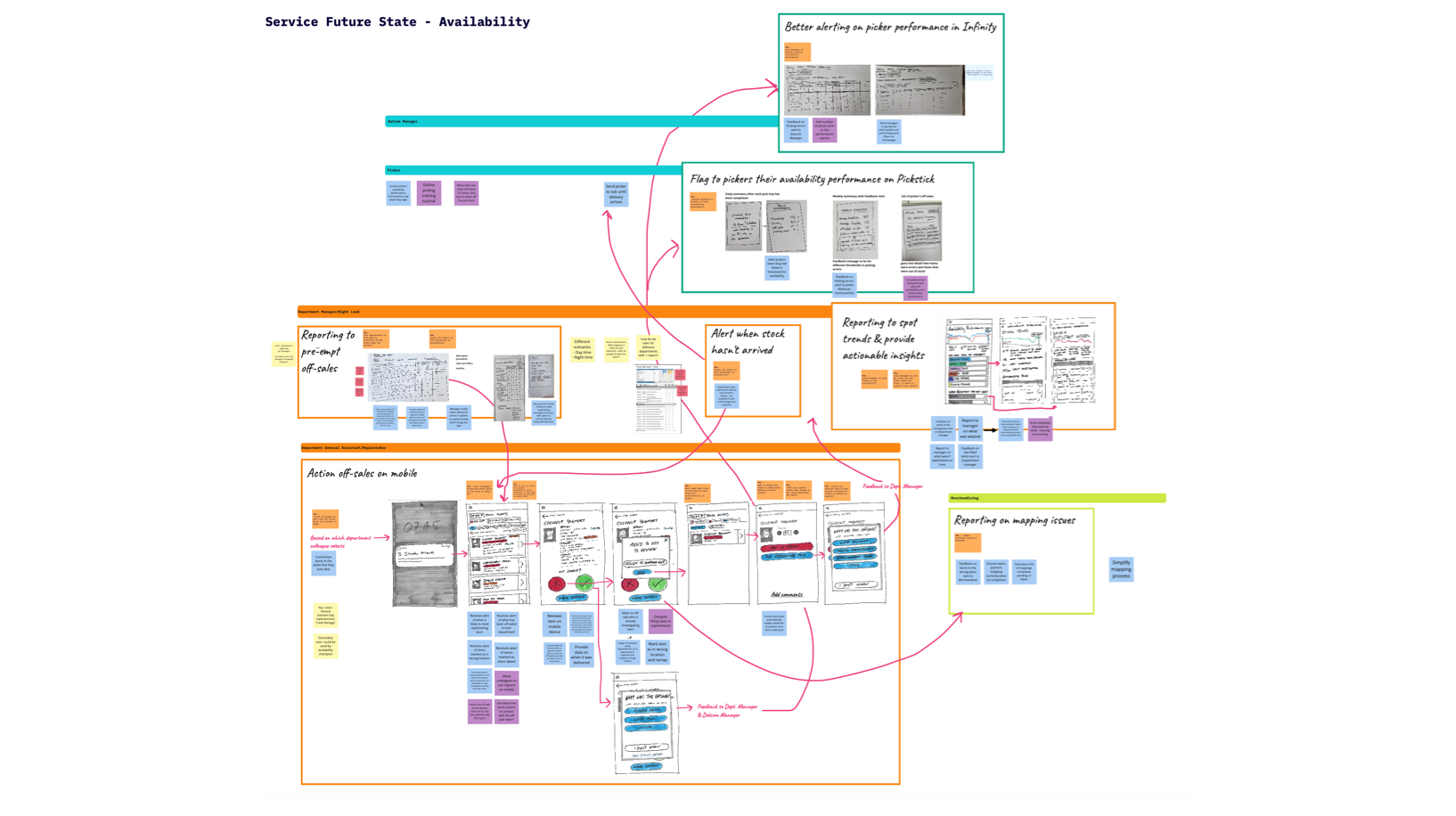Product Manager
Year
2022
My Role
-
- Senior Researcher
Disciplines
- Service Design
- User Research
- UX Design
Helping Tesco manage online customer orders
A multinational retailer, Tesco provides customers with affordable and sustainable food through a workforce of 330,000 colleagues. They fulfill over 1 million online grocery orders weekly via Automated Warehouses, Superstores, and Tesco Express stores.
Product availability is the percentage of fulfilled products in customer orders. While Automated Warehouses achieve 98% availability, Superstores and Express Stores range from 90-95%, falling short of Target’s industry standard of 97%. Despite a new Data and Reporting dashboard, not all stores effectively utilise it.
The discovery project’s aim was to identify key barriers to reaching the 98% target. Assessed whether investing in the internal processes with data and reporting would improve performance.
The Process
What I did
Project kick offs
Stakeholders workshops
Quantitative research
Analysing internal existing data to see trends and define potential hypotheses as a starting point in the research
Enthographic Research
Using metric data to make strategic decisions for selecting stores to interview
Choosing to have a data sample to represent the 350+ UK stores. Only visiting 12 stores allowed easier data collection because they are cost-effective, convenient, and manageable. Also conducted the following during the research:
- Field studies of Super Stores, Express stores and Distribution centres.
- Walk-through of backstage processes warehouse + delivery area, picking areas
- Observations and interviews
The process allowed me to understand the pain points of the staff and how the backstage and front stage processes worked together – giving a holistic view of how the fulfilment process works.

Embedding new research processes due to the scale of the data sample
- Implemented in-store colleague interview process with Store Managers utilising Excel spreadsheets for planning, scheduling, and booking.
- Efficiently gathered key quotes and manually coded them.
- Streamlined output creation by utilising video footage and extracting still photos rather than relying on separate audio and photos.
Discovery in numbers
15
56
1000
Created service blueprints for each store type to compare the key differences in operational processes
The blueprints show that late deliveries have a knock-on effect on the entire store’s processes that progresses throughout the day. There is also no real-time reporting, leading to inaccuracies and delays in achieving stock accuracies within stores. Also, noticed there were no preventative ways to ensure stock is available due to the delay in the data reporting.
Service blueprinting the digital and offline touch points within each process and the stakeholders involved
Below are some of the zoomed-in service blueprints and personas. It became apparent that the availability target was managed by multiple job roles with no clear ownership. Some stores hired Availability champions, which is NOT a typical role within the staff structure – which meant it was taking the budget out of the Picking team.
Operational and reporting pain points impacting fulfilment orders
These are the top pain points impacting the processes to do stock fulfilment and current touch points and reporting. Also got a lot of feedback through colleague surveys to confirm that the research was gather was accurate. Late deliveries were number 1 on the list and our team was able to gather findings and insights from the Deliveries department and relevant Product Manager.
Using the impact matrix to access which problem statements we should focus on.
The challenge of impact metrics is we realised that it was an impossible task to rate impact since any potential solution could solve all the problems, or just one or two. In a small workshop, the Product team were able to ideate some ideas to help with the impact matrix. On one end of the spectrum, it could be a new basic MVP where it’s just a new report, or could be a full new product which connects data from all staff.
At this point, it was decided to have a Design Sprint and co-design with people who work on the Shop floor as a better way of design as the new solution would have an effect on their everyday routines instore.
Outcomes
This required taking a holistic view of the fulfilment process, using service design skills and working closely with Business and Product stakeholders to solve the right problems, using data to lead decisions and ensuring everything we did would add maximum value to the customer.
Design Sprint/ Co-design workshop as next step
• The discovery allowed the team to move forward to have a 2-week Design Sprint which included the users themselves, to trial potential solutions in a real-life Tesco store with a new proposed staff routine.
Research hypothesis cleared
• Quickly clear up business stakeholders’ hypotheses and found key findings and problem areas to focus on.
Potential research bias
During the research, I found there was some bias to the data which could have impacted the data collection due to stores selected.
FPS downloads do not fully indicate how many times it has been used by members of staff, as Dotcom staff may download it once and printed several reports to managers, so couldn’t confirm the exact impact of the current reporting system Infinity.
Also, store sales numbers are dependent on the size of the store and its location e.g. a large city centre with high traffic would have the highest sales, which can affect the availability targets due to shop floor traffic getting in the way of pickers and stock being taken off the shelves during the picking of foods.






















